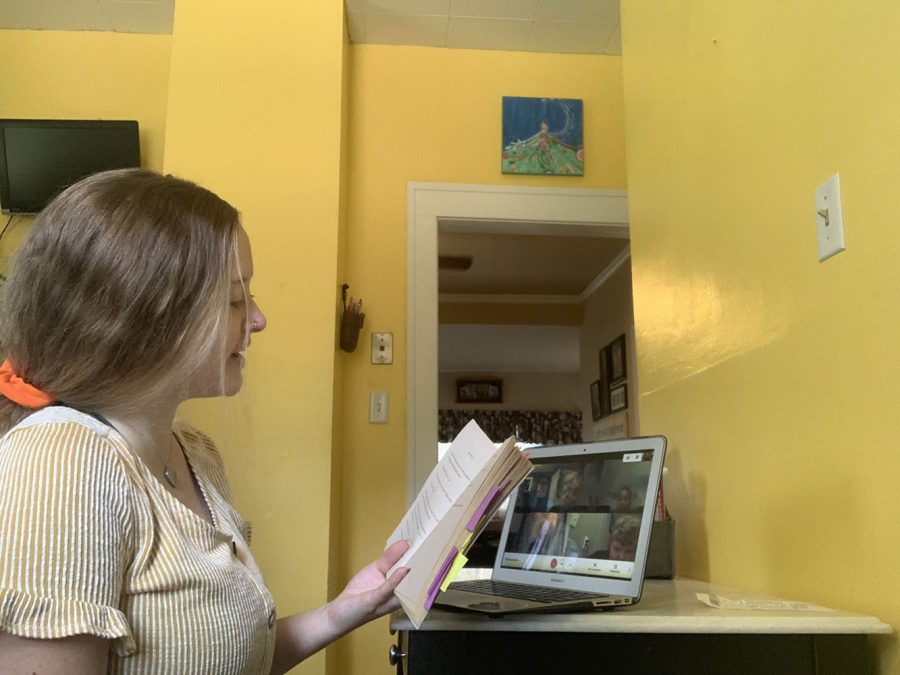University of Iowa education majors continue student teaching online
Students in the UI College of Education are required to complete a semester of student teaching, which comes with pandemic-specific challenges.
University of Iowa student teacher, Emma Lindskog, reads aloud a book to her fourth grade class on Sept. 17.
September 21, 2020
To become a licensed teacher and graduate from the University of Iowa’s College of Education, students are required to complete a semester of student teaching. Already a major hurdle for education majors, COVID-19 has set the bar even higher.
As most K-12 schools transition into either hybrid or online education, student teachers are adapting to the style of the school they are stationed at.
UI student Emma Lindskog teaches elementary students and said she was supposed to do some of her student teaching abroad in Ireland, but the trip was canceled. The school where she is instead, Kate Wickham Elementary School in Iowa City, uses a hybrid format in which students are split up into A, B, and C groups.
C students were completely online, and A and B were alternating hybrid days, Lindskog said. Because there is such small number of students, she is only teaching those in the A and C groups.
“We do a lot of asynchronous learning because we’re having to teach it in person and online at the same time,” she said. “It’s really hard to get to know your kids and give them feedback to make sure they’re learning because you really don’t get to talk to them as much.”
UI student Thomas Hartley, a student teacher at Highland Elementary, is also experiencing teaching from a hybrid format. He said one thing that has been difficult is teaching the same lesson two days in a row and teaching in a hybrid model is double the work as he is planning out the lessons.
“When they’re at home on their off-site days, we have to plan at least three subjects full of instructions on math, reading and writing is what our district has decided as a priority.” Hartley said.
He said he felt prepared from his education at the UI to adapt to the technology, but it does not necessarily prepare student teachers for teaching online.
“How do you get a kid to work with you and pay attention when they’re at home — when there’s a lot of different stimuli — on top of the socio-emotional needs of the kids stuck at home because of the pandemic?” he said. “School is routine and consistency, and the kids are just not getting the consistency.”
RELATED: COVID-19 and distance learning affect student-teaching experience
Lindskog said even among college students, some are receptive to online learning while others struggle, just like the children she teaches. She said some students can’t focus online or can’t understand the technology.
She added that some of the parents are struggling with online or hybrid models, as well.
“I know some parents have struggled with it just because they do have full time jobs,” Lindskog said. “So that is difficult, but you know they’re kind of having to help their kids walk through things online but I mean who knows if they’re working from home or if they’re working somewhere else, that a kid is kind of left to figure things out, so that’s difficult on a parent’s perspective.”
UI student Erin Cork is teaching in Mount Vernon, Iowa. She mentioned the challenges of fulfilling requirements during the pandemic.
“It’s called TPA [Teacher Performance Assessment], which is basically the requirements to get your teaching license. Instead of having an end of the semester test, [student teachers] submit a portfolio.” she said. “You have to do instruction planning to come up with four different lessons and you have to write up lesson plans for how you will assess them afterwards. The second task is an actual video clip of you teaching.”
Cook added that there has been no change to these requirements despite student teachers that may be required to teach online classes. Even with all the uncertainty, both Hartley and Lindskog said they are grateful for the experience.
Hartley said the pandemic has allowed him to value in-person instruction even more than before COVID-19.
He said that when he teaches in the future, he plans on focusing less on things like lecturing, when he can spend his time socializing with students and allowing them to have fun.
Lindskog said she has concerns about transitioning from a hybrid style of teaching back to in person, but she said it is all part of the education field in general.
“I think the field of education in general you have to be very flexible and go with the flow,” she said. “I mean this is the state of our world right now as people go into education. So, do whatever you can to help the child learn, regardless of what the situation is.”



